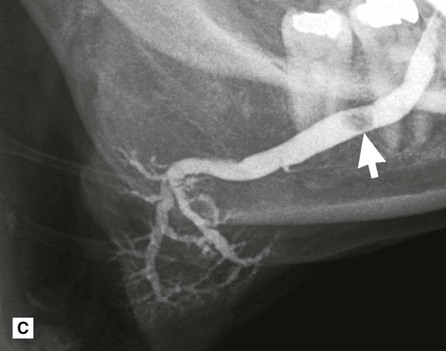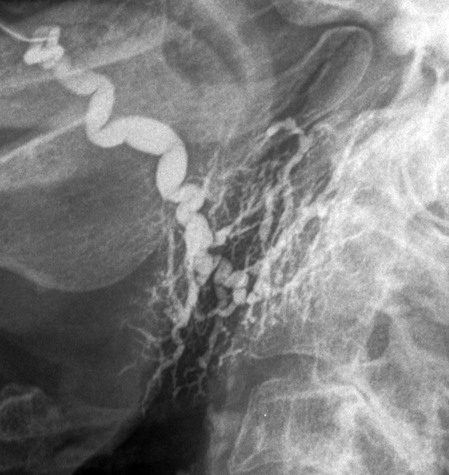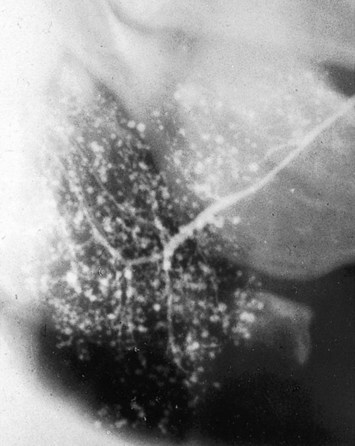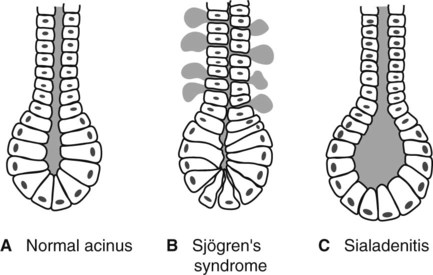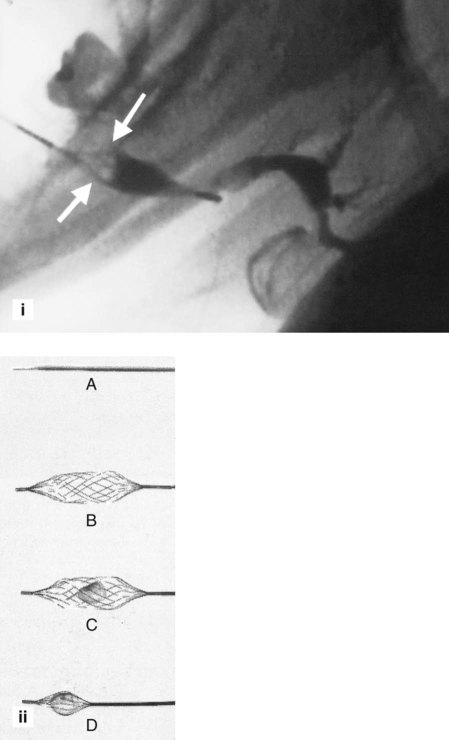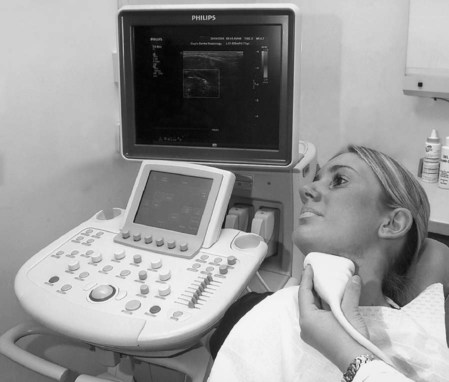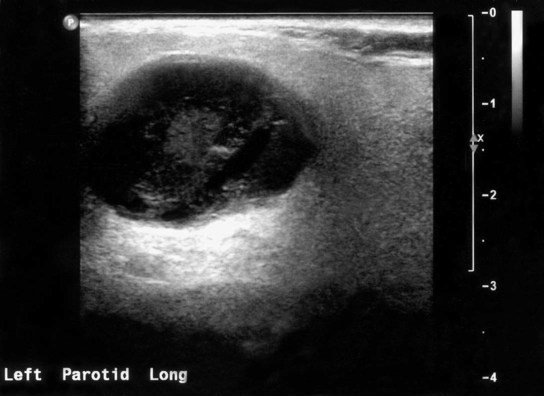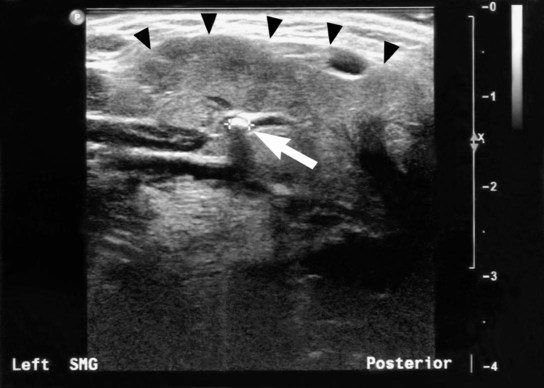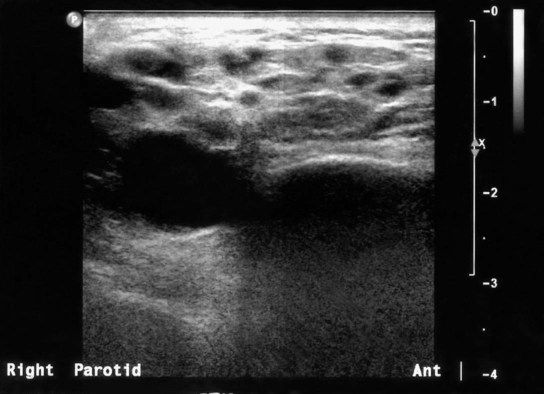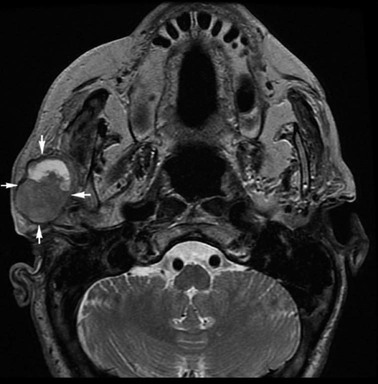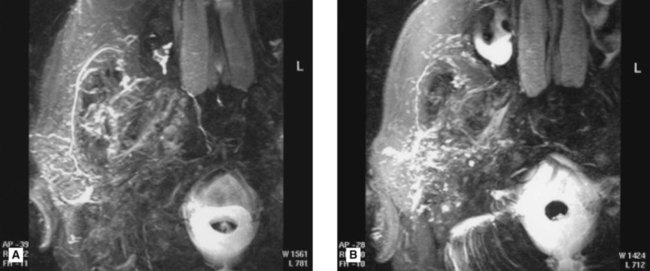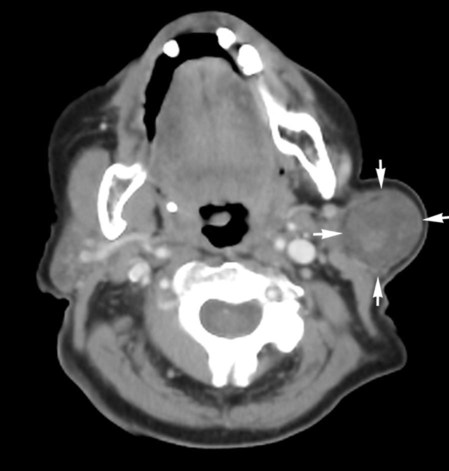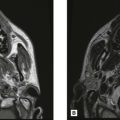The salivary glands
Salivary gland disorders
• Acute intermittent generalized swelling of a gland, often related to meals
• Acute generalized swelling of one or more glands
• Chronic generalized swelling, often involving more than one gland
The important causes of these complaints are summarized in Table 32.1.
Table 32.1
A summary of the main salivary gland complaints and their causes
| Salivary gland complaint | Cause |
| Acute intermittent generalized swelling |
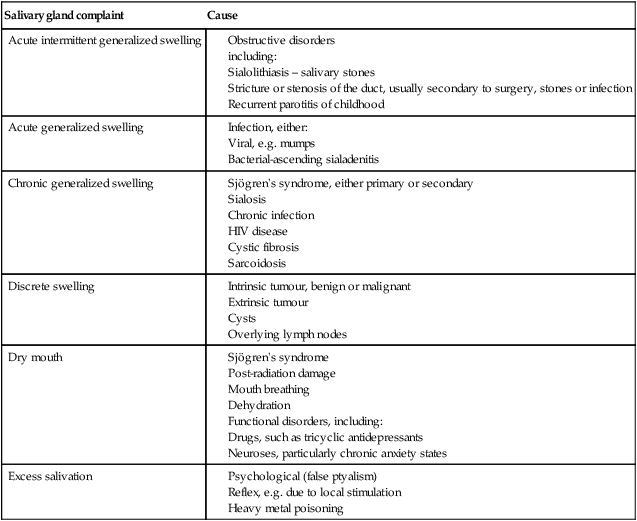
Investigations
Plain radiography
The most common disorder of the major salivary glands is obstruction caused either by salivary stones (calculi) or stricture of the ducts. A large proportion of salivary calculi are radiopaque (approximately 40–60% in the parotid and 80% in the submandibular glands) so patients presenting with obstructive symptoms of acute intermittent swelling require routine radiographs to determine the presence and position of the stone(s), as shown in Fig. 32.1.
The radiographic projections used commonly for the parotid and submandibular glands are summarized in Table 32.2.
Table 32.2
A summary of the commonly used radiographic projections for the parotid and submandibular glands
| Salivary gland | Radiographic projections used |
| Parotid |

Sialography
The procedure is divided into three phases.
Contrast media used
The types of contrast media (see Ch. 18) suitable for sialography are all iodine-based, and include:
Most radiology departments use aqueous solutions. Their relative advantages and disadvantages are summarized in Table 32.3.
Table 32.3
A summary of the advantages and disadvantages of oil-based and aqueous contrast media
| Contrast | Advantages | Disadvantages |
| Oil-based |

Note: Since the contrast medium is not being introduced into the bloodstream, there is no need to use the safer, but more expensive, non-ionic contrast media discussed in Chapter 18.
Contraindications
The main contraindications include:
• Allergy to compounds containing iodine although gadolinium may be used as an alternative
• Periods of acute infection/inflammation, when there is discharge of pus from the duct opening
• When clinical examination or routine radiographs have shown a calculus close to the duct opening, as injection of the contrast medium may push the calculus back down the main duct where it may be inaccessible.
Sialographic techniques
The control of infection measures detailed in Chapter 7 are of particular importance, and should be adhered to during sialography. In addition, the wearing of eye protection glasses and a mask by operators is recommended.
These techniques can be summarized as follows:
Sialographic interpretation
Once again, the essential requirements include:
• A systematic approach (see Fig. 32.3)
• A detailed knowledge of the radiographic appearances of normal salivary glands
• A detailed knowledge of the pathological conditions affecting the salivary glands.
Normal sialographic appearances of the parotid gland
Normal sialographic appearances of the submandibular gland
• The main duct is of even diameter (3–4 mm wide) and should be filled completely and uniformly
• This gland is smaller than the parotid, but the overall appearance is similar with the branching duct structure tapering gradually towards the periphery – the so-called bush in winter appearance (see Fig. 32.5).
Pathological appearances
Sialographic appearances in Sjögren’s syndrome include:
• Widespread dots or blobs of contrast medium within the gland, an appearance known as punctate sialectasis or snowstorm (see Fig. 32.10). This is caused by a weakening of the epithelium lining the intercalated ducts, allowing the escape of the contrast medium out of the ducts
• Considerable retention of the contrast medium during the emptying phase
An understanding of the underlying disease processes explains why the sialographic appearances of sialadenitis and Sjögren’s syndrome (two totally different conditions) are so similar. This is shown diagrammatically in Fig. 32.11.
Sialographic appearances of intrinsic tumours include:
• An area of underfilling within the gland, owing to ductal compression by the tumour
• Ductal displacement – the ducts adjacent to the tumour are usually stretched around it, an appearance known as ball in hand (see Figs 32.12 and 32.13)
• Retention of contrast medium in the displaced ducts during the emptying phase.
Note: If modern imaging, e.g., ultrasound or CT, is available, sialography for intrinsic tumours is no longer performed.
Interventional sialography
Conventional sialographic techniques can be supplemented and expanded into minimally invasive interventional procedures by using balloon catheters and small Dormia baskets under fluoroscopic guidance. The balloon catheter, as the name implies, can be inflated once positioned within a duct to produce dilatation of ductal strictures. The Dormia basket may be used to retrieve mobile ductal salivary stones (see Fig. 32.14). Both these procedures are now being used successfully to relieve salivary gland obstruction without the need for surgery.
Ultrasound
Ultrasound imaging of the salivary glands as shown in Fig. 32.15 is becoming increasingly common. Modern high resolution scanners produce excellent images and that coupled with the numerous advantages shown below has elevated ultrasound to the imaging modality of choice for many patients with salivary gland disorders, as shown in Figs 32.16–32.18.
Advantages
• Ionizing radiation is not used
• Provides good imaging of superficial masses
• Useful for differentiating between solid and cystic masses and for identifying the nature and location of the margins of a lesion
• Different echo signals from different tumours
• Assessment of blood flow using colour Doppler
• Identification of radiolucent stones
• Lithotripsy of salivary stones
• Ultrasound-guided fine-needle aspiration (FNA) biopsy possible
Magnetic resonance (MR)
Indications
Advantages
• Ionizing radiation is not used
• Provides excellent soft tissue detail, readily enables differentiation between normal and abnormal
• Provides accurate localization of masses (see Fig. 32.19) and may be able to distinguish benign from malignant tumours
• The facial nerve may be identifiable
• Images in all planes are available
• Co-registration possible with PET scans
• MR sialography may be performed (see Fig. 32.20) together with MR spectroscopy
• Water in the ducts and glands can be visualized to create MR sialographs without the use of contrast agents (see Fig. 32.20)
• MR spectroscopy can be performed to differentiate different tissues by their chemical constituents.
Radioisotope imaging
Indications
• Dry mouth as a result of salivary gland diseases such as Sjögren’s syndrome
Computed tomography (CT)
Indication
Disadvantages
• Provides no indication of salivary gland function
• Risks associated with intravenous contrast media if used (see Ch. 18)
• Fine duct detail is not well imaged
• May be difficult to distinguish tumours in the submandibular gland from normal gland tissue (due to similar density).
To access the self assessment questions for this chapter please go to www.whaitesessentialsdentalradiography.com

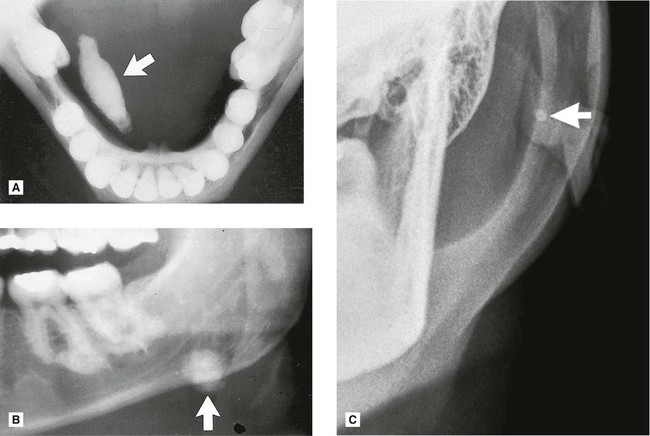
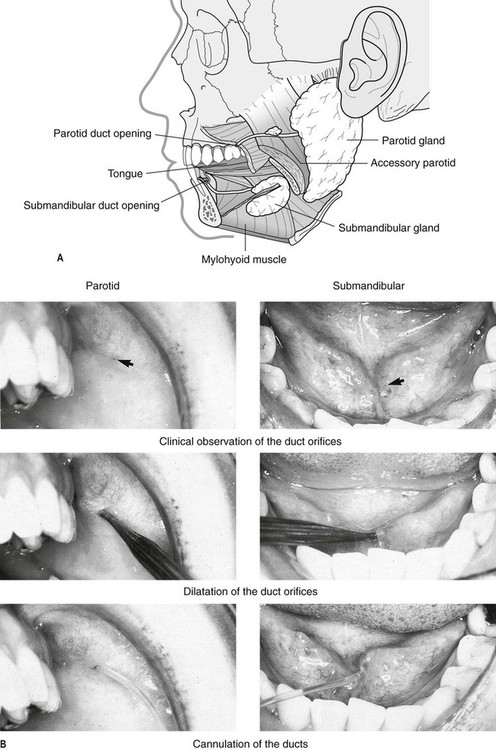
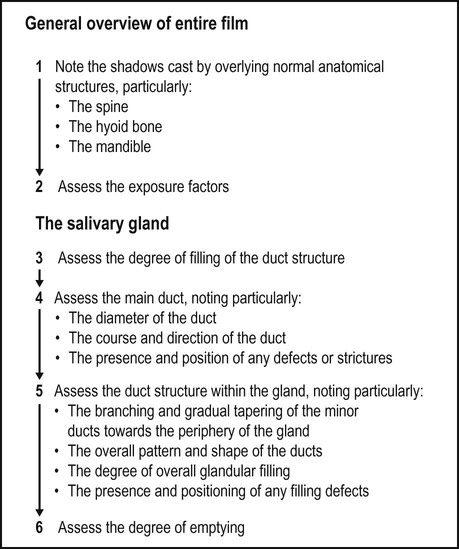
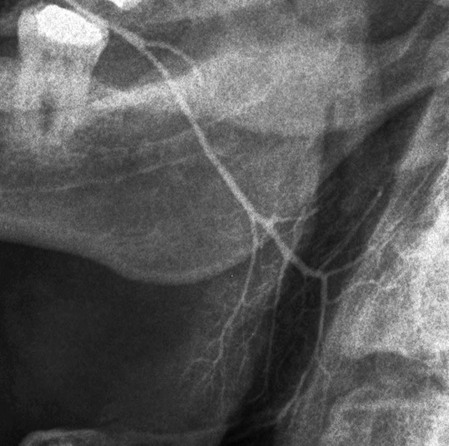
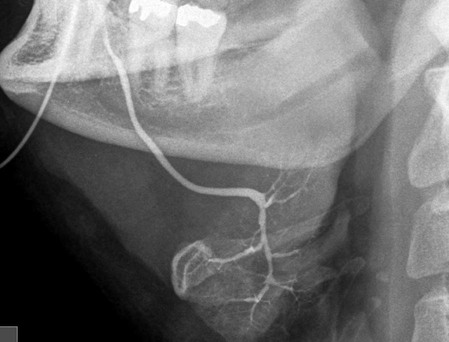
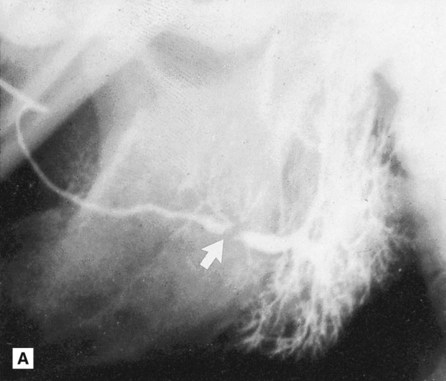 />
/>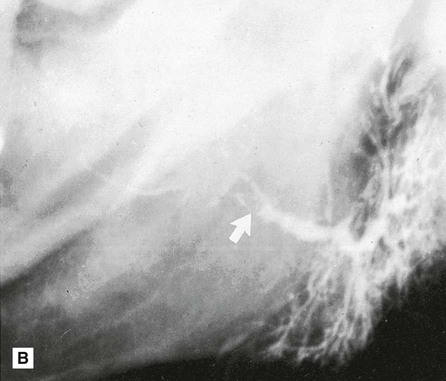 />
/>